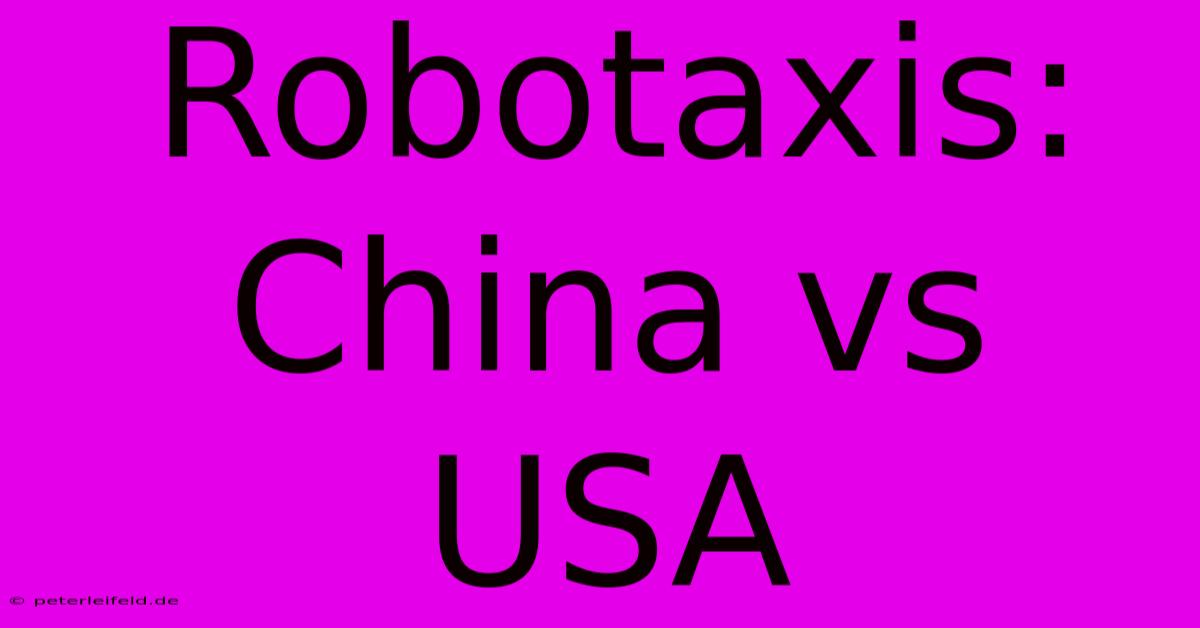Robotaxis: China Vs USA

Discover more detailed and exciting information on our website. Click the link below to start your adventure: Visit Best Website Robotaxis: China Vs USA. Don't miss out!
Table of Contents
Robotaxis: A Head-to-Head Showdown Between China and the USA
Hey everyone! So, you wanna know about the crazy race between China and the US to dominate the robotaxi game? Buckle up, because it's a wild ride. I’ve been following this stuff for years – and let me tell you, it's way more complicated than just "who's got the best tech."
The Tech Battle: Autonomous Driving Capabilities
First off, let's talk tech. Both countries are throwing billions at this thing. The US, with companies like Waymo and Cruise, focuses a lot on high-definition mapping and super-precise sensor tech. Think lasers and cameras working together like a super-powered, self-driving superhero team. They're aiming for a gradual rollout, focusing on controlled environments first – you know, before unleashing a fleet of driverless cars onto busy city streets.
China, on the other hand, is taking a slightly different approach. Companies like Baidu and Pony.ai are aggressively testing in crowded cities, pushing the boundaries of what's possible. They're using a blend of technologies, sometimes relying more on AI algorithms to make sense of chaotic traffic, rather than solely on super-precise mapping. This is where things get REALLY interesting!
My Personal Blunder (and What I Learned)
I’ll be honest, I initially thought the US had a clear lead. I was so wrong. I remember reading an article a few years back that totally focused on the US advantage, completely glossing over the rapid advancements in China. It made me look foolish, and it taught me a valuable lesson: never underestimate the power of a competitor! You gotta stay updated and look at all the data, not just what confirms your biases.
The Regulatory Landscape: A Game Changer
Now, here's where things get REALLY tricky. The regulatory environment is VASTLY different between the two countries. In the US, things are, let’s say, complex. You've got different state laws, federal guidelines...it's a regulatory maze. Getting permits and approvals can take forever. Imagine the headache for a company trying to deploy a large fleet of robotaxis nationally!
China, surprisingly, has been way more proactive in setting national standards and streamlining the approval process. It’s not perfect – they still have safety concerns to address – but their regulatory framework is arguably more conducive to faster robotaxi deployment. This is a HUGE advantage that I initially underestimated.
The Infrastructure Factor: Roads, Maps, and More
Think about this: you need amazing infrastructure for robotaxis to work effectively. High-quality maps, well-maintained roads, and reliable communication networks are all essential. The US has some world-class infrastructure, but it's also got some seriously outdated parts. Potholes, inconsistent road markings, and varying signal timing are all things self-driving cars need to overcome.
China's investing heavily in upgrading its infrastructure, including smart traffic management systems. They're building infrastructure specifically designed for autonomous vehicles. This gives them a significant edge in creating a favorable environment for robotaxi adoption.
Public Acceptance and Cultural Factors
Believe it or not, public perception also matters a lot. There's often more of a willingness to adopt new technologies in China, in my opinion. Plus, the sheer scale of the population needing transportation solutions creates massive demand and the potential for rapid market expansion.
In the US, there is, of course, a strong preference for personal vehicle ownership and the freedom that comes with it. That’s also impacting the acceptance of shared, autonomous vehicles.
The Bottom Line: It's a Tight Race
So, who's winning? It's honestly too close to call. Both countries have strengths and weaknesses. The US boasts cutting-edge technology and deep pockets, but regulatory hurdles and infrastructure challenges create serious headwinds. China’s aggressive approach, supportive regulations, and focus on infrastructure upgrades give it a potential for rapid growth.
One thing is for sure: this is a marathon, not a sprint. The next few years will be absolutely critical in determining which country emerges as the global leader in the robotaxi revolution. And trust me, I'll be right here, following the action! Stay tuned!

Thank you for visiting our website wich cover about Robotaxis: China Vs USA. We hope the information provided has been useful to you. Feel free to contact us if you have any questions or need further assistance. See you next time and dont miss to bookmark.
Featured Posts
-
Neuer Laptop Windows Trumpft Apple Auf
Nov 21, 2024
-
Preisbrecher Windows Laptop Schlaegt Apple Mac Book
Nov 21, 2024
-
Lokale Ki Fuer Temenos Banking
Nov 21, 2024
-
Coloplast Aktie Zeitverlauf Bewertung
Nov 21, 2024
-
Le Bron 16 Teams Uebersehen Knecht Talent
Nov 21, 2024
